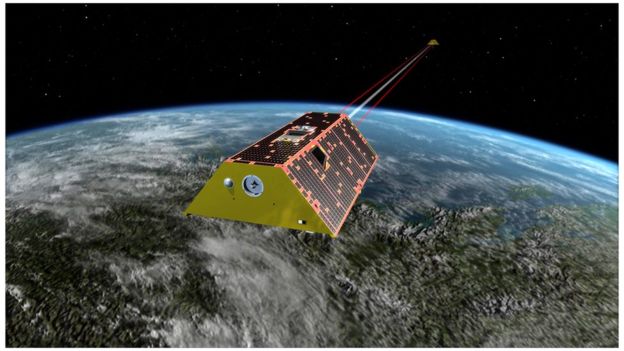The Grace satellites are replacing a pair of highly successful spacecraft that stopped working last year.
Like their predecessors, the new duo will circle the globe and sense tiny variations in the pull of gravity that result from movements in mass.
These could be a signal of the land swelling after prolonged rains, or of ice draining from the poles as they melt in a warming climate.
The satellites were launched on Tuesday aboard a SpaceX rocket from the Vandenberg Air Force base in California.
It will take a number of weeks to prepare and test the spacecraft before they can start gathering data.
The first Gravity Recovery and Climate Experiment (Grace), which ran from 2002 to 2017, was widely regarded as transformative in the type of information it was able to gather, and maintaining the capability is now seen as a top priority for the American space agency (Nasa).
The follow-on mission again draws heavily on expertise from Europe, in particular from the German Research Centre for Geosciences (GFZ). Europe's biggest space company, Airbus, assembled the satellites at its factory in Friedrichshafen.
The Grace duo will obtain their data by executing a carefully calibrated pursuit in orbit.
As the lead spacecraft lurches and drags through the Earth's uneven gravity field, the second satellite will follow 220km behind, measuring changes in their separation to the nearest micron (a thousandth of a millimetre).
"That is about a tenth of the width of a human hair over the distance between Los Angeles and San Diego," Prof Frank Flechtner, the Grace-FO project manager at GFZ, told BBC News.
What the Grace concept is brilliant at sensing is the big changes that occur in the hydrological cycle.
These could, for example, be major movements of water from the ocean to the land during precipitation events.
"There was a period in 2011 when sea-level rise slowed down and went in the other direction very briefly," explained Nasa project project scientist Dr Frank Webb.
"From the Grace data we could see there were heavy rain seasons in Australia and South America, and that equivalent of mass was going into storage on land. Eventually, it was released back to the oceans and sea-level rise continued."
One of the great contributions from the first Grace mission was to confirm the scale of change at the poles - to essentially weigh the ice sheets year on year.
Satellites carrying altimeters can do this by measuring the change in shape of Antarctica and Greenland - but Grace provided completely independent insight through its gravity assessments. Antarctica was seen to be losing some 120 billion tonnes of ice a year; for Greenland, the figure was 280 billion tonnes.
"Mass loss from the ice sheets is an increasing contribution to total sea-level rise and, even though the poles are remote, this mass loss will have large impacts all around the world," said Prof Helen Fricker from the Scripps Institution of Oceanography.
"With the launch of Grace-FO, we can now continue to detect changes in the ice mass, to determine the extent to which ice is being lost, and find out if there has been any acceleration," she told BBC News.
The previous Grace pair used a microwave-ranging instrument to measure their separation.
The new satellites carry the same technology, but have now a laser system incorporated as well. It should give a roughly 10 times improvement in precision.
And although this is unlikely to deliver an equivalent jump in the resolution of the gravity field, scientists are still hopeful they can get significant gains in performance.
The total cost for Grace-FO is on the order of $520m (€440m; £390m). The mission should work for at least five years.
As to what follows the follow-on, there is already talk about trying to widen involvement to include more EU member states.
This could eventually see a future Grace-like gravity mission pulled into the European Commission's Sentinel Earth-observation programme.
The same has already happened with the US-French Jason series, which has been measuring sea-surface height since 1992.
Future Jasons will be known as the Sentinel-6 mission - a status that has helped secure long-term funding.
"I think it's important we get an operational mission," commented Prof Flechtner.
"The 'e' in Grace stands for 'experiment', but the data is now being used for services, such as flood monitoring. My strong opinion is that it could be a Sentinel."
More about: ORBIT
















































